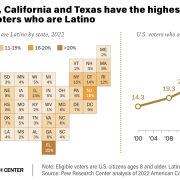Trust the Science: The Blue State Surge is Real
For months the conventional wisdom among Democrats, amplified by their obliging claque in the media, was that lockdowns played an essential role in containing COVID-19. The great heroes, in addition to Anthony Fauci, were hardline governors like Michigan’s Gretchen Whitmer, California’s Gavin Newsom and, most of all, New York’s Andrew Cuomo.
Yet now, more than a year later, the lockdown states—starting with New York and New Jersey—are again leading the nation in coronavirus infections and deaths per capita.
By contrast, some of the states with Republican governors who were routinely castigated for unlocking things and supposedly killing their residents, most notably Florida, Georgia and Texas, did indeed suffer an increase in fatalities last summer. But since then, even after opening their economies, these states continue to suffer fatality rates per capita well below those of the locked-down Northeastern states and about equal to California, which has maintained one of the nation’s strictest lockdowns.
What emerge from these trends are some clear issues with transmission that transcend lockdowns, mask mandates and other punitive measures. However justified, such actions have not addressed the fundamental reasons why some geographies and populations have suffered so much more than others. That’s to say that while the blue state governors aren’t necessarily to blame for the surges their states are experiencing, it’s clear that the economically and personally disruptive measures did not have the expected impact.
What did make a big difference, it turns out, is not so much the severity of lockdowns but pre-existing conditions. The likely cause here can be best identified as “exposure density” brought on by crowded housing, transit, and office environments.
That helps explain why, after New York City’s suburbs were hit hard in the first wave, the current surge has hit the outer boroughs, where a much higher share of workers have had little choice but to continue taking the subway or other transit.
Nationwide, urban exposure to the pandemic also reflects their greater inequality. Higher rates of poverty and overcrowded housing accentuate the worst effects of the pandemic, which tore through impoverished parts of New York, Houston, Los Angeles County, Chicago’s poor south side, and similar areas. The Bronx, for example, has suffered an 80 percent worse death rate than denser yet wealthier Manhattan, while Brooklyn’s rate is 50 percent worse than Manhattan’s.
This can be seen also in the Los Angeles metropolitan area, whose sunshine-blessed and auto-dominated society suffered a fatality rate 60 percent below that of transit-oriented metro New York. Yet while fatality rates have been very low in affluent areas with fewer crowded households, such as west Los Angeles and Irvine, they have been much higher in areas like east and south Los Angeles. In Orange County, the fatality rate in affluent, single family dominated Irvine is 22 per 100,000 compared with 195 in neighboring Santa Ana, which is heavily Hispanic, poor and suffers crowded housing conditions.
This is an international phenomenon seen across the world’s great urban areas. During the first lockdown, almost 20 percent of the Parisian population fled to the countryside, accelerating an escapist trend that had been underway for years: the core city of Paris has lost 700,000 residents (nearly 25 percent of its population) since 1954, while millions of new inhabitants have swelled the suburban population. Meanwhile, the densely packed Department of Seine-Saint-Denis, a place synonymous there with inner ring suburban poverty, had a staggering 130 percent excess mortality rate when the virus first hit last year.
Read the rest of this piece at The Daily Beast.
Joel Kotkin is the author of The Coming of Neo-Feudalism: A Warning to the Global Middle Class. He is the Presidential Fellow in Urban Futures at Chapman University and Executive Director for Urban Reform Institute. Learn more at joelkotkin.com and follow him on Twitter @joelkotkin.
Wendell Cox is principal of Demographia, an international public policy firm located in the St. Louis metropolitan area. He is a founding senior fellow at the Urban Reform Institute, Houston, a Senior Fellow with the Frontier Centre for Public Policy in Winnipeg and a member of the Advisory Board of the Center for Demographics and Policy at Chapman University in Orange, California. He has served as a visiting professor at the Conservatoire National des Arts et Metiers in Paris. His principal interests are economics, poverty alleviation, demographics, urban policy and transport. He is co-author of the annual Demographia International Housing Affordability Survey and author of Demographia World Urban Areas.
Photo credit: Matryx via Pixabay under CC0 1.0 License.





 DonkeyHotey, via Flickr, under CC 2.0 License
DonkeyHotey, via Flickr, under CC 2.0 License

 Kenu Lund, used under CC 2.0 License
Kenu Lund, used under CC 2.0 License